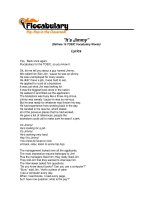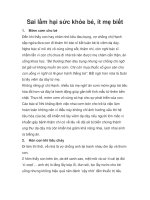It cabling specifications doc 100715v1 0
Bạn đang xem bản rút gọn của tài liệu. Xem và tải ngay bản đầy đủ của tài liệu tại đây (747.01 KB, 16 trang )
Level 57, MLC Centre
19-29 Martin Place
Sydney, NSW, 2000
Australia
Tel: +61 2 9238 2075
P.O Box 2029
Bondi Junction
NSW, 1355
Australia
Tel: +61 2 8012 5461
HOTEL STRUCTURED DATA
CABLING SPECIFICATIONS
Project and Property
Crowne Plaza Vientiane, Laos
15 July 2015
Version: Draft 100715v1.0
“This specification only covers the cabling infrastructure for public areas, guestrooms and back of house areas as
defined within. Note this does cover the office tower that does not have a connection to the hotel.”
Commercially in Confidence
Réitech Pty Ltd ©
Page 1
1. OVERVIEW
The property is located in Vientiane, Laos and is currently under construction with a
targeted opening date of April 2016. The property shall require new IP ready data
cabling network throughout the property to allow for newer technologies and services
to be delivered for both guests and administration staff of the hotel.
Summary of key features of the property
Basement level provides access to the car parking and back of house (“BoH”)
facilities.
Ground level provides access to the hotel lobby, reception, meeting space,
lounge and bar facilities.
Level one provides access to the ballroom, kitchen and all day dining facilities.
Level two provides access to the members lounge, executive offices, staff
canteen and BoH facilities.
Level three provides access to the day spa, fitness centre, pool and pool bar
facilities.
Levels four through to ten provide access to 203 guestrooms.
This is the initial stage of the IT project in specifying the data cabling infrastructure
requirements during the construction phase bearing in mind the type of system to be
installed on to the data network. Following on from this infrastructure document we
will begin to specify the systems and solution to be installed during the IT and Security
FF&E process in meeting on the IHG brand requirements. The following is a high level
summary of the systems which shall be expanded on during the IT FF&E
procurement/tender process;
Public wired and wireless internet access.
o Wireless Access Points (WAP) internet locations shall be installed within
the guestrooms on the guest floors (every second room) to provide the
required coverage at 5 GHz AT -65dBm.
These WAP’s shall be located at or near the desk located (out of
sight) and include additional LAN ports for wired IP services in
the guestroom.
Wired internet for the desk shall be connected back to this WAP
LAN port. (It is proposed this wired LAN lead is terminated to a
RJ45 data female wall socket located or the desk or wall near the
desk.)
o External WAP’s in the public areas shall be located in the roof cavity, near a
service hatch for maintenance.
Telephone/Voice. (PABX)
o Analogue and Digital Voice Services
Closed Circuit Televisions. (CCTV)
Television channel distribution. (IPTV)
IHG secure administration network; physically segmented from the public
network and exclude any wireless connectivity.
o Property Management System (PMS)
o Point of Sale (POS)
o Guestroom and BoH key card system (Door Locks)
Need clarification if guestroom door locks will be networked
centrally for reporting purposes and integration for PMS checkin and check-out (requires ZigBee connectivity).
o Other administration software and systems
Commercially in Confidence
Réitech Pty Ltd ©
Page 2
Attachment A to I is provided as reference drawings to assist on cabling locations and
terminations. These locations may change depending on ID design requirements and
changes going forward by the design teams. Any change impacting IT requirements
should be discussed with the IT Consultant.
NOTE: We have not allowed for any data requirements for building controls, devices and
management (BMS) or Energy Management as we believe this is covered under the MEP
scope. To be advised if required.
2. PROJECT OVERVIEW
The following data cabling scope covers hotel guestrooms, hotel public areas, hotel
function areas and hotel administration areas located on the following levels.
Basement Level
Ground Level
Level One
Level Two
Level Three
Level 4 to 10, Guestrooms
It must be noted that we have provided the proposed design based on the information
provided to date and will require the final approval of IHG and the owners for
implementation. There are locations within the property where design has yet to be
completed and/or does not allow for any changes to the current Interior designs
changes as at 1 July 2015.
This scope needs to be integrated and priced in line with the initial cabling specification
document covered under the MEP Tender Documentation.
3. SITE VISITS AND DOCUMENTATION
If there is a requirement to discuss any part of the overall IT and Technology for this
property you can contact the IT Consultant on the below details to arrange for site
visits, floor plans and/or discussions.
Réitech Pty Ltd (IT Consultant)
Allan Smith
Mobile: +61 (0)413747992
Email:
Skype: allan.g.smith
4. DATA AND VOICE CABLING SPECIFICATION AND GUIDELINES
The following is provided as a guideline to the contractors in delivering a structured
cabling network infrastructure that meets the recommended international standards
and specifications required for data and voice services.
CAT3 cabling
Fifty (50) pair CAT3 UTP (or foiled due to EMI concerns) shall only be used for
this project to connect the riser IDF Krone 110 connection blocks (punch down
Commercially in Confidence
Réitech Pty Ltd ©
Page 3
blocks) back to the Computer Room (MDF) master Krone 110 connection
blocks; which will intern will be connect to the hybrid PABX (analogue and
digital).
CAT6 cabling
Category 6 Class E UTP and F/UTP (CAT6) shall be used for this project (1-250
MHz) or if budget allows Category 6A (1-500MHz) shall be used as a minimum
for this project. The decision as to whether UTP or foiled UTP will be used will
depend on the risk of EMI or cross talk interference. Noise due to EMF can
impact the quality of the VOIP and Video Conferencing services, so foiled UTP
should be used if EMF is going to be an issue; as a rule of thumb we should
allow at least 1.2 meter between data cabling and electrical cabling.
CAT6 cabling is to be used between the IDF locations and end termination wall
sockets. The maximum allowable length for any one CAT6 cabling run is
90meters and shall not exceed 90 meters. RJ45 connections shall be used for
terminating all CAT6 cabling.
NOTE: Unless otherwise specified only RJ45 connections shall use when terminating CAT6
cabling. Please see further information reference to analogue voice installation
requirements.
Multimode Fibre Optic
OM4 laser optimised Multi-Mode fibre optic cabling shall be used for the core
backbone cabling linking all the edge IDF locations across the property back to
the Computer Room (MDF). As a minimum it is a requirement to install 8 cores
(4 pairs) between the IDF location and MDF.
5. CABLING CONTRACTOR REQUIREMENTS
The Cabling Contractor must possess the applicable Cabling Registration and
must comply with the International Standard for Installation of the structured
cabling.
The Cabling Contractor is to be a certified installer of the cable and connectivity
manufacture and should be on site at all times during the cabling installation.
The Cabling Contractor shall provide all cabling materials and services for the
installation of the cabling system, including ducting, patch panels, terminations
etc.
6. WARRANTY
All installed cabling systems shall be fully certified, and guaranteed for a
minimum of 20 years.
The Contractor shall supply the following:
o Cable and optical fibre test results in hard and soft copy;
o Cabling plant continuity test results;
o Marked up floor plans showing outlet numbers and locations;
o Consolidation point plans and specifications (if applicable);
o Manufacturer’s warranty certification;
o Certification that the cabling installation meets, or exceeds, the minimum
specified standard.
Commercially in Confidence
Réitech Pty Ltd ©
Page 4
7. COMPLIANCE
International data cabling standards shall be enforced and maintained when
installing the structured cabling infrastructure.
All equipment used shall be certified for electrical compliance by recognised
authority and identified by way of the product labelling.
All equipment used shall be designed to comply with the electromagnetic (EMC)
and electromagnetic radiation (EMR) International standards.
Fire and underwriters compliance. All equipment and/or material shall be
supplied and installed to meet the local standards and certification
requirements
8. GENERAL REQUIREMENTS
The structured cabling installed shall consist of horizontal cabling between data outlets
and a 24 port patch panel mounted in an IDF or MDF nominated locations. The IDF
locations shall be connected back to the Computer Room (MDF) via CAT3 (analogue
telephony only) or Multi-mode Optical Fibre cabling. All outlets and patch panel
positions will be numbered, labelled and documented. The documentation will also
include the results of the specified tests and a marked up floor plan showing outlet
numbers and locations.
8.1 Computer Room (MDF)
Attachment B provides a proposed design for the computer room based on the services
and infrastructure requirements of the hotel.
It is the hotel preference for all cabinets to be floor mounted where possible.
The MDF will have a separate air conditioning system in addition to any
building air conditioning system in place and be maintained at 20 degrees
Celsius at all time. This separate system shall operate 24X7 and will ensure the
hotel’s investment in IT assets is protected at all times.
Apart from a separate rack mounted UPS provided by suppliers the MDF shall
be connected to a protected power supply, the building UPS or generator
system.
It is preferred that the MDF has anti-static flooring and ideally have an
advanced smoke detector system installed.
All door, window or ceiling gaps should be minimised to maintain dust free
environment within the MDF.
The MDF should have a dedicated building earth cable installed in the room on
an appropriately sized earth bar, to be determined in consultation with the
electrical engineer.
The height of each room must be greater than the height of equipment cabinets,
in this situation the ceiling to floor should be at least 2.8 meters.
A horizontal and vertical cable duct/tray shall be supplied and installed to carry
data cables from the ceiling space to the equipment cabinet for maintaining and
protecting the cables. These ducts/trays should allow for future cable capacity.
8.2 Horizontal and Vertical Cabling
Attachment A provides a high level cabling methodology for the building.
Commercially in Confidence
Réitech Pty Ltd ©
Page 5
Each data communications outlet shall be cabled to the RJ45 patch panel
located in the IDF or MDF without any joints. Taps or splices are not to be used.
All installed horizontal cable shall conform to the latest edition of ISO/IEC
11801.
The CAT6 cable to each work area data communications outlet shall consist of
4 twisted pairs.
Should be terminated using RJ45 style connector or patch panel unless
specified otherwise due to analogue telephone requirements.
Cable bends shall maintain the minimum bend radius specified by the
manufacturer, but shall be no less that 25mm in radius.
If the cabling access’s fire rated walls, ceilings or floors then such holes shall be
filled using approved fire materials so as to maintain the existing fire rating.
Sufficient slack shall be maintained within the cable so as to reduce any risk of
damaging cable or connections due to excessive tension in the cables.
Vertically run cables shall be mounted on to cable trays and secured every
300mm using cable ties.
Any data cabling that runs in parallel to power cables; will allow for at least a
350mm separation between the data and power cabling.
The horizontal sub-system is star connected with each cable being a maximum
of 90 metres. Where a horizontal sub-system cannot be established within the
90-metre limitation, a second IDF shall be established to install a second
horizontal sub-system to meet the specification.
Depending on the physically installed network hardware equipment and physical
network separation for security reasons, each IDF located network switch shall be
connected back to the MDF location core switches via multi-mode optical fibre cable as
specified. As a minimum;
All multi-mode fibre optic cables shall be installed to meet ISO/IEC 11801.
Single mode fibre optic cabling shall only be used on consultation with the IT
Consultant.
All fibre optic cable shall meet the minimum transmission performance
specified in ISO/IEC 11801.
The fibre optic cables shall be of a construction to handle rugged building riser
applications. Include the correct cladding and outer protection to meet the
environmental conditions.
Fibre optic cables shall be clearly labelled.
All fibre optic cable shall be free of stress or mirco-bends reducing the
performance of the cables.
The main fibre optical patch panel for the building shall be located in the MDF
room. All fibre optic backbone cables shall originate from this location to each
of the IDF locations, unless otherwise specified.
8.3 Terminations
The cabling contractor shall be responsible for the termination of the horizontal
and vertical cable, including cables, patch panels, pin assignments, pair
allocation and colour coding shall conform to ISO/IEC 11801 or as directed by
the IT Consultant.
o Secure administration and public data cable termination should be
colour coded to reflect the different structured cabling networks, as
they are to remain physically separated.
Sufficient slack of cable shall be left behind the termination area to ensure that
terminations and cable are not under tension.
Commercially in Confidence
Réitech Pty Ltd ©
Page 6
The IT Consultant should be contacted to the design and layout of the
terminations within the equipment rack locations; IDF and MDF locations. A
proposed layout is provided in a later section.
The correct tools are to be utilised for terminating cables and shall be of a type
approved by the manufacturer for the connectors used.
The cable twist rate shall be maintained at the RJ45 outlets and RJ45 patch
panel.
The fibre optic cabling shall use the inter-connect methodology for the establishment of
circuits. The connectors of equipment fly leads shall be connected directly to the
connectors of the backbone cable.
Fibre optic cabling connectivity shall be in accordance with ISO/IEC 11801.
All cables shall be neatly butted and stripped, ensuring that fibres and jacketing
are undamaged.
All optical fibres shall be either fusion spliced on to optical fibre pigtails which
have been factory pre-terminated with type SC connectors, or terminated
directly on site to type SC connectors. LC connectors may be used in
consultation and approval by the IT Consultant.
Contractor shall provide evidence that the quality of the termination will be as
good as if it were made in the factory if they terminate on site
All connectors shall be supplied with protective caps fitted. The Contractor
must take steps during the installation to ensure that dust does not enter optic
fibre cabling.
Fibre optic termination enclosures (rack mounted or wall mounted) shall be of
metal construction with a fully enclosed compartment to house the cable entry,
splice trays and bare fibre. Whether rack mounted or wall mounted the
enclosures must be designed to anchor all optical fibre cables in place to
prevent movement and resulting potential degradation of performance or
damage to cables and terminations.
8.4 Outlets and Faceplates
The following requirements may vary depending on the location and in consultation
with the IT and/or interior design consultant.
Unless otherwise stated each work area shall be provided with:
o A white faceplate, unless specified otherwise by the interior decorating
architects,
o RJ45 or RJ11 female connector,
All faceplates shall be mounted horizontally and flush mounted on walls,
skirting duct and/or furniture where possible. Where mounting blocks are
required and raised away from the wall then the mounting block shall be the
same colour as the faceplates.
Location of the faceplates will be determined by the interior design
requirements and team, in consultation with the IT Consultant.
8.5 Data, Fibre Patch Panels and Patch Cables
24 Ports RJ45 female patch panels are to be provided unless otherwise
specified within the 19” racks.
All patch panels shall comply with the relevant standard for CAT6 specifications
and suitable for terminating CAT6 cables.
Patch cables shall be provided for interconnection between the patch panel and
the active equipment located in the equipment cabinet. Each patch cable shall
Commercially in Confidence
Réitech Pty Ltd ©
Page 7
be terminated with the pin assignments, pair allocation and colour coding
configuration T568A, and ISO/IEC 11801.
Fibre optic patch cables shall be a maximum of one meter in length used
between the fibre optic patch panel and the active equipment located in the
equipment cabinets. SC type connectors and all patch leads must be tested by
the manufacturer ISO/IEC 11801.
Fly leads shall be provided to connect the RJ45/RJ11 outlets and user
equipment, terminated with the pin assignments, pair allocation and colour
configuration T568A, and ISO/IEC 11801 or in the case of RJ11 the
configuration need to meet analogue telephone configuration.
The inclusion of an integrated rear cable management system should be used to
better manage the cables.
The cable management panels should be mounted on the patching facility
between every two rows of connection ports. In this way, patch leads from
every patch panel port are directed to the cable management panels above or
below the outlet, so that at no time, even when fully populated, outlets are
obscured by patch leads
8.6 Labelling
All outlets and patch panels shall be labelled by the contractor, in accordance with
ISO/IEC 11801.
Quality labelling materials shall be durable or protected from damage or fading
of port information. Types of labels;
o printed paper labels inserted into a recess in the faceplate;
o embossed, self-adhesive plastic tape systems (Dymo style);
The label shall clearly identify the type of service and location. The label details
shall identify the cable at both ends for use by the network equipment installers
etc. All data port should be documented in to a spreadsheet for ease of use by
other following/post installation of the cable infrastructure.
RJ45 multiple outlets on a single faceplate shall be labelled from left to right and
then from top to bottom.
All distribution RJ45 patch panels shall be clearly labelled and be labelled with
the same designations as the corresponding cable end/outlet. The order of
appearance of horizontal cables on the patch panel shall commence with the
lowest numbered outlet appearing at the top left and proceed left to right, and
then top to bottom.
Where 110 punch block panels (Krone) are used for analogue terminations, a
booklet shall be completed and maintained to identify the telephone extensions
to the block port number.
Where RJ45 patch panels are located in the same rack or group of racks for
backbone cabling then these shall be identified by the numbering system used
to identify these cables from the core backbone cabling.
Commercially in Confidence
Réitech Pty Ltd ©
Page 8
The label used for each fibre core shall consist of a numbering system that
identifies the location, cable bundle and number core. EG: Core 02-A3 is second
floor, third core of the first optical cable.
8.7 LAN Active Equipment
The supply, installation and configuration of LAN and WLAN network equipment will
be covered under a separate specification document for managed network and internet
services. It shall be dealt with under the IT FF&E process once the network is finalised.
8.8 Testing
All cables shall be tested for Ethernet operation by the contractor according to a formal
test plan. The test plan shall be submitted to the IT Consultant for approval prior to the
commencement of testing and must confirm the operation of the cabling installation.
An approved hand-held test instrument shall be used to perform the tests.
Documented test results shall be provided to the IT Consultant.
All fibre optic cabling shall be tested for loss and uniformity of transmission
characteristics using a recording optical TDR. The test methods to be employed for
optical fibre cable testing should be submitted to the hotel for approval prior to
commencement of testing.
The test shall be performed from each end of the fibre.
Connector loss should be measured for optical fibre fly leads.
Acceptable loss measurements are as defined in ISO/IEC 11801.
A copy of the test results shall be included within the documentation and
provided to the IT Consultant
8.8 Tools
The Contractor shall use specific tools required to carry out the installation of the
cabling system and include a punch down tool for each type of termination utilised.
8.9 Documentation
8.10
The hotel will provide to the Contractor copies of the site plan on request for
the installation of the cabling structured cabling infrastructure.
The Contractor shall provide to the IT Consultant upon completion of the work
following documentation:
o as built drawings showing the physical location and designation of each
cable route, cable ducts and cable trays, marked up on drawings
o cable run list of the end location of each cable by room
o copies of all test results
o update any local service records as required
o completed forms necessary to meet the local regulations requirements
o documentation of all cabling components used
o manuals supplied with the installed equipment if any
Standards
ISO/IEC 11801- Patch Cords and work Area.
IEEE 802.3
Carrier Sense, Multiple Access with Collision Detection
(CSMA/CD) Access Method and Physical Layer Specifications.
Commercially in Confidence
Réitech Pty Ltd ©
Page 9
ISO/IEC 11801 Information Technology – Generic cabling for customer
premises
9. SCOPE OF WORKS (“SoW)”
This section provides the high level specifications and requirements for the
implementing the required cabling infrastructure. If there is any confusion, conflict in
specifications, clarification required or change approvals required; please contact the
IT Consultant.
9.1 Computer Room - MDF (See Attachment B)
Located on the 2nd floor next to the service lifts servicing the executive offices.
Supply and install four (4) lockable 19” 42U rack (with glass door) having
internal fans for extracting the heat once loaded with servers and switching.
Supply and install a 240V GPO power rail to the rear within the 19” rack to
allow power for approx. 8 servers and/or switches to be connected per rack.
Supply and install 19” rack mounted fibre optic patch panels for terminating all
fibre optic cables from the IDF locations. This patch panel shall be located at the
top of the 19” racks were applicable.
Supply and install 19” 24 port RJ45 patch panels within the applicable racks by
service for the horizontal CAT6 cabling located within 90 meter of the MDF.
Supply and install 19” 24 port RJ45 patch panels within the applicable racks by
service for the horizontal CAT6 cabling located within 90 meter of the MDF.
Supply, install, test and document the Krone 110 punch down blocks for the
PABX analogue telephone system.
Terminate, test and label the multimode fibre optic cables within the 19” rack.
Dual SC termination is to be used, if different please specify. Note: HP switching
shall be used for this project.
The computer room shall be maintained at 20 degrees Celsius at all times. The
computer room HVAC shall be independent and connected to backup power
source.
The computer room shall be equipment with dry fire extinguish equipment to
limit the damage to computer. Water sprinkler system is not preferred.
Unless otherwise specified the layout of all cabinets/racks shall conform to the
following order:
o Top of Rack / Cabinet
o Cooling Fans
o Power Rail vertical at the rear
o Optic Fibre terminations
o Optic fibre cable management
o CAT6 UTP Terminations
o Cable management
o Active network equipment
o Servers
o UPS backup Power (not required if a centralised UPS is provided for the
whole computer room)
9.2 Vertical Optical Fibre Cabling and Cabinets – IDF (see Attachment A)
Currently there appears to one vertical risers running up the building for use
from the Basement to Level 10. However, we do see additional riser IDF
locations to be made available on the lower levels; Basement, Ground, 1, 2 and 3
levels due to the larger foot print of the hotel.
Commercially in Confidence
Réitech Pty Ltd ©
Page 10
Supply, install, terminate, test and label eight (4 pair) multimode optical fibre
cables between the MDF and each IDF locations, running up the vertical risers.
Supply and install a lockable 19” 10U wall mounted rack (with glass door) in
the IDF for terminating the optical fibre cables, RJ45 cables and network
switching equipment. (space will define the depth)
Supply and install 19” 24 port RJ45 patch panels for terminating the CAT6
cabling.
Supply and install a 19” rack mounted fibre patch panel for terminating all fibre
optic cables connected back to MDF location. This patch panel shall be located
at the top of the 19” rack.
Supply, install, terminate, test and label Guestroom CAT6 to the RJ45 patch
panels.
Supply, install, test and document the Krone 110 punch down blocks for the
PABX analogue telephone system. (not located in the 19” cabinet)
Multimode optical fibre dual SC terminations to be used, if different please
specify in the pricing sheet. Note: HP switching shall be used for this project.
A minimum of a 6 way 15 amp 240 V rated power rail will be fitted internally
including an isolating switch in the incoming supply, and a terminal block for
connection of the supply conductors. The power rail will connect to the
incoming supply through a GPO at the top of the cabinet enabling isolation of
the equipment cabinet in the event the cabinet has to be removed or relocated.
The power distribution outlets will be rated at 10A for flexibility of equipment
connection. Earthing shall comply.
The Contractor shall install the cabinets in the position indicated by the IT
Consultant/Project Manager. The Contractor shall install the patch panels,
shelves and data cabling in the cabinets.
Sufficient cable slack shall be provided to allow the rack to open for access to
the rear of the cabinet.
There may be locations that require communications cabinets that are wall
mounted and suitable for the accommodation of active equipment and patch
panels due to location or space concerns. Such locations are to be discussed
with the IT Consultant.
Unless otherwise specified the layout of all cabinets/racks shall conform to the
following order:
o Top of Rack / Cabinet
o Cooling Fans
o Power Rail vertical at the rear
o Optic Fibre terminations
o Optic fibre cable management
o CAT6 UTP Terminations
o Cable management
o Active network equipment
o UPS backup Power
9.3 Horizontal CAT6 structured cabling (see Attachment A)
Supply, install, terminate test and label CAT6 cables between the IDF RJ45
female patch panel and a RJ45 female data wall plate point except where an
analogue telephone service is being delivered.
Where an analogue telephone extension is located. The CAT6 cabling shall be
terminated to the Krone 110 punch down block in the IDF and a RJ11 wall plate
at the end point. Where there is more than one analogue telephone connected
to a single telephone extension; the telephones shall be terminated in parallel in
the guestroom.
Commercially in Confidence
Réitech Pty Ltd ©
Page 11
9.4 Supply, install and commission of a data and voice network as defined
A. Basement Level (see Attachment D)
o
o
o
Supply, install, terminate, test and label the following CAT6 cabling
from the RJ45 wall sockets location to the 19” Cabinet located in the
IDF.
Supply, install, terminate, test and label the following CAT6 cabling
from the RJ11 analogue telephone wall sockets location to the 19”
Cabinet located in the IDF.
Known Locations;
Housekeeping Offices (locations to be determined)
2 x PMS
2 x Analogue Telephone
2 x Admin LAN
Laundry Room (locations to be determined)
2 x Analogue Telephone
2 x Admin LAN
Plant Rooms
2 x Analogue Telephone
Hotel Guest Lifts
1 x IP CCTV
Hotel Service Lifts
1 x Analogue Telephone
1 x IP CCTV
Office Lifts
1 x IP CCTV
General Car Parking Area
9 x IP CCTV
5 x WAP
B. Ground Level (see Attachment E)
o
o
o
Supply, install, terminate, test and label the following CAT6 cabling
from the RJ45 wall sockets location to the 19” Cabinet located in the
IDF.
Supply, install, terminate, test and label the following CAT6 cabling
from the RJ11 analogue telephone wall sockets location to the 19”
Cabinet located in the IDF.
Known Locations;
Front Office
16 x VoIP (RJ45)
16 x Admin LAN
1 x IP Printer
3 x IP CCTV
Hotel Guest Lifts
1 x IP CCTV
Hotel Service Lifts
1 x IP CCTV
1 x Analogue Telephone
Office Lifts
1 x IP CCTV
Driveway (External)
2 x IP CCTV
Commercially in Confidence
Réitech Pty Ltd ©
Page 12
Lobby and Lobby Lounge
5 x IP CCTV
3 x WAP
? x IPTV (unknown)
Lobby Bar
3 x VoIP (RJ45)
9 x Admin LAN
1 x IP CCTV
Porter Desk
1 x VoIP (RJ45)
2 x Admin LAN
3 x IP CCTV
Pre-meeting room lobby
1 x VoIP
2 x IP CCTV
2 x WAP
5 x IP Digital Signage
Meeting Rooms (5 x meeting rooms)
7 x IPTV
2 x WAP
16 x Data Ports
5 x VoIP
1 x IP CCTV
Back of House (BoH) – including delivery bay
1 x WAP
10 x Data Ports (locations to be determined/no ID)
3 x VoIP
6 x IP CCTV
C. Level One (see Attachment F)
o
o
o
Supply, install, terminate, test and label the following CAT6 cabling
from the RJ45 wall sockets location to the 19” Cabinet located in the
IDF.
Supply, install, terminate, test and label the following CAT6 cabling
from the RJ11 analogue telephone wall sockets location to the 19”
Cabinet located in the IDF.
Known Locations;
Host Station (All Day Dinning)
1 x VoIP (RJ45)
3 x Admin LAN
1 x IP CCTV
Hotel Guest Lifts
1 x IP CCTV
Hotel Service Lifts
1 x IP CCTV
1 x Analogue Telephone
Waiter Stations (2 locations)
4 x Admin LAN
2 x VoIP
All Day Dinning General
2 x WAP
1 x VoIP (service kitchen)
4 x IP CCTV
Commercially in Confidence
Réitech Pty Ltd ©
Page 13
Ballroom Pre-function Lounge
3 x IP Digital Signage
1 x Data Port
1 x IP CCTV
1 x WAP
Ballroom
10 x VoIP
3 x WAP
10 x Data Port
Ballroom pre-function Bar
1 x VoIP (RJ45)
3 x Admin LAN
1 x IP CCTV
Banquet Managers Office
1 x VoIP (RJ45)
2 x Admin LAN
Chefs and Stewards Office
3 x VoIP (RJ45)
6 x Admin LAN
Main Kitchen
2 x VoIP (RJ45)
4 x Admin LAN
Room Service Office
2 x VoIP (RJ45)
4 x Admin LAN
Kitchen General
4 x IP CCTV
D. Level Two (see Attachment G)
o
o
o
Supply, install, terminate, test and label the following CAT6 cabling
from the RJ45 wall sockets location to the 19” Cabinet located in the
IDF.
Supply, install, terminate, test and label the following CAT6 cabling
from the RJ11 analogue telephone wall sockets location to the 19”
Cabinet located in the IDF.
Known Locations;
Executive Lounge
3 x VoIP (RJ45)
2 x Data Ports
2 x WAP
1 x IPTV
Hotel Guest Lifts
1 x IP CCTV
Hotel Service Lifts
1 x IP CCTV
1 x Analogue Telephone
Executive Lounge Reception
6 x Admin LAN
2 x VoIP (RJ45)
1 x IP CCTV
Executive Meeting Rooms (2 x meeting rooms)
2 x IPTV
2 x VoIP (RJ45)
Commercially in Confidence
Réitech Pty Ltd ©
Page 14
2 x Data Ports
2 x Digital Signage
Computer Room
See MDF for more details
Back of House (BoH)
5 x IP CCTV
2 x WAP
40 x VoIP (RJ45)
40 x Admin Port
BoH Training Room
No details, provision for wireless and wired
network.
BoH Meeting Room
1 x VoIP (RJ45)
1 x Admin Data
1 x Data Port
BoH Chief Engineers Office
2 x Admin Port
2 x VoIP (RJ45)
BoH Workshops
2 x Data Ports
2 x Admin Ports
2 x IPTV
2x VoIP (RJ45)
Staff Canteen
1 x VoIP (RJ45)
1 x IPTV
Other
2 x IP CCTV
1 x WAP
E. Level Three (see Attachment H)
o
o
o
Supply, install, terminate, test and label the following CAT6 cabling
from the RJ45 wall sockets location to the 19” Cabinet located in the
IDF.
Supply, install, terminate, test and label the following CAT6 cabling
from the RJ11 analogue telephone wall sockets location to the 19”
Cabinet located in the IDF.
Known Locations;
Pool Bar
2 x VoIP (RJ45)
6 x Admin Ports
1 x IP CCTV
Pool/Bar Area
1 x IP CCTV
1 x WAP
Hotel Guest Lifts
1 x IP CCTV
Hotel Service Lifts
1 x IP CCTV
1 x Analogue Telephone
Spa Reception
1 x VoIP (RJ45)
Commercially in Confidence
Réitech Pty Ltd ©
Page 15
3 x Admin Ports
1 x IP CCTV
Spa Area
1 x WAP
Gym Reception
2 x VoIP (RJ45)
6 x Admin Ports
1 x IP CCTV
Gym
1 x WAP
2 x IPTV
1 x IPCCTV
F. Level Four to Ten (see Attachment C)
o
o
o
Supply, install, terminate, test and label the following CAT6 cabling
from the RJ45 wall sockets location to the 19” Cabinet located in the
IDF.
Supply, install, terminate, test and label the following CAT6 cabling
from the RJ11 analogue telephone wall sockets location to the 19”
Cabinet located in the IDF.
Known Locations;
Hotel Guest Lifts (all floors)
1 x IP CCTV
Hotel Service Lifts (all floors)
1 x IP CCTV
1 x Analogue Telephone
Level 4 to 10 Guestrooms
30 x IPTV
90 x Analogue Telephone
30 x Data Port (these will be used for connected
wireless AP in every second guestroom)
Level 4 to 10 Corridors
1 x IP CCTV
1 x WAP
Roof top
1 x Analogue Telephone
3 x IP CCTV
1 x Data Port
1 x Admin Port
Commercially in Confidence
Réitech Pty Ltd ©
Page 16









